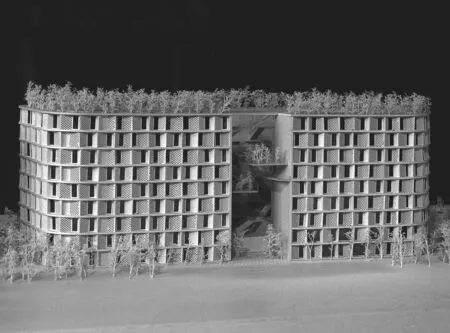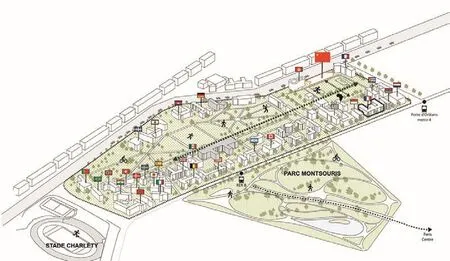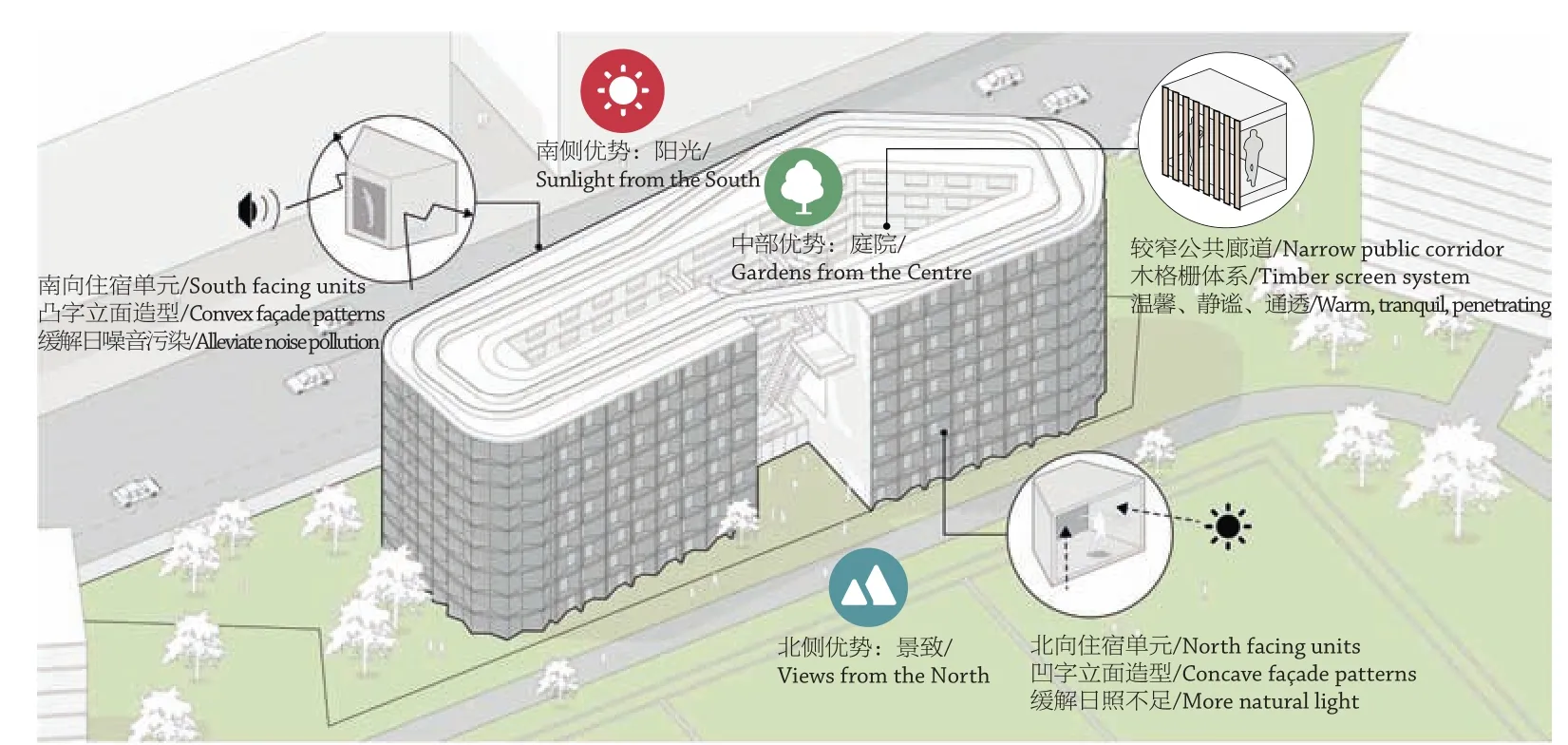巴黎国际大学城“中国之家”,巴黎,法国
巴黎国际大学城“中国之家”,巴黎,法国
Maison de la Chine, CIUP, Paris, France
评论
王骏阳:巴黎大学城素有小型“国家联盟”之称,这里已有40多个国家的留学生公寓,其中最为著名的无疑是勒·柯布西耶于1930-1932年间完成的瑞士学生公寓。当时的柯布正致力于现代建筑的探索,“新建筑五点”“光明城市”、底层架空、玻璃幕墙,这一切都反映在瑞士学生公寓的设计中。可以说,无论从技术还是美学角度,该建筑都充满创新精神,也是巴黎大学城第一个具有现代主义特征的建筑。
然而,勒·柯布西耶关于城市和建筑思想的诸多问题也伴随在这个建筑之中。首先,“光明城市”能否构成一个好的城市模式?从张永和近年来在城市问题上的发声来看,这是一个值得质疑和反思的模式。不奇怪的是,在“中国之家”项目中,底层架空和独立式建筑单体的“光明城市”模式被传统的围合模式所取代,无论其原型来自中国的客家大院还是巴黎的奥斯曼城市街区(即使底层部分架空仍然在外围保持基本围合)。与此同时,一个巨大的豁口在面向大操场的立面上形成,由此带来与传统原型相异的围合方式。内院中的公共楼梯被巧妙地安排在这个豁口位置,既为整个建筑赋予某种纪念性和公共性的入口,又可形成独特的建筑亮点。
勒·柯布西耶最初为瑞士学生公寓设计了一个玻璃砖加可开启透明玻璃窗的南立面,之后改为玻璃幕墙。如同差不多同时建成的巴黎救世军总部大楼一样,这在实际使用中导致房间冬冷夏热的不适,直到1950年代的幕墙改造和遮阳处理后,情况才有好转。与此不同的是,“中国之家”为每个房间赋予阳台或凸窗的立面厚度,并以此形成角度各异且足以带来立面变化的砖砌花格墙体,在夏季使用空调不甚普及的巴黎,这无疑有助于改善室内环境,也对遮挡南侧公路的交通噪音起到一定作用,尽管这种“双层表皮”在当代建筑中已比比皆是。
屋顶花园是勒·柯布西耶“新建筑五点”的重要元素,但在瑞士学生公寓只得到十分有限的运用。相比之下,“中国之家”不仅在内院屋顶形成花园,而且将它作为整个建筑的重要元素予以表现。勒·柯布西耶为屋顶花园提出的理由之一是它有助于改善平屋顶的保温隔热,这在当今不算什么了不起的理由,在“中国之家”肯定也可以接受。只是顶层屋顶花园如何使用可能会是一个不确定的问题。非常建筑的解决方案是在屋顶形成环形光伏跑道。但是面对已经存在的地面大操场和大学城良好的室外步行系统,人们不免还是会对这个跑道的必要性产生怀疑。而且,如果不仅作为一个勒·柯布西耶式的“建筑漫步”元素,还是真正具有运动和健身作用(一种现代主义理想),那么这个跑道似乎又过于平坦,空间力度不够。
无论如何,这是一个在诸多层面都值得我们期待的项目。
Comment
WANG Junyang:The Cité Internationale Universitaire de Paris is always referred to as a miniature"Association of Nations". It includes more than forty apartment buildings to house exchange students from all over the world. The most famous building is undoubtedly the Pavillon Suisse, designed by Le Corbusier and completed between 1930-1932. At that time, Le Corbusier was ardently exploring modern architecture; the Five Points of Architecture, the"Radiant City", piloti, and glass curtain walls, which are all reflected in the design of the Pavillon Suisse. It can be said that, whether from a technological or aesthetic perspective, this building is full of innovation. It is also the first piece of modernist architecture in the Cité Internationale Universitaire de Paris.
However, several problems in Le Corbusier's ideas on cities and architecture are present in this building.First, could the "Radiant City" actually constitute a good urban model? Considering the views expressed in recent years by Yung Ho Chang regarding urban issues, this model is worthy of criticism and reflection.It is not surprising that in the "Maison de la Chine"project, the piloti and independent building units from the "Radiant City" have been replaced by the traditional courtyard model, regardless of whether the prototype for this model comes from China's Hakka courtyards, or from Haussman's Paris city blocks (even if the ground level is only partially composed of piloti,a peripheral basic enclosure will be maintained). At the same time, a very large opening facing the playground forms a different type of enclosure when compared to traditional prototypes. The public stairs within the courtyard are ingeniously arranged at the opening,giving the building a monumental and public entrance,and also forming a unique architectural highlight.
In his initial plan for the Pavillon Suisse, Le Corbusier designed a southern façade using glass tiles and glass windows that could be open and transparent; later he changed these plans to a glass curtain wall design. Like the Cité de Refuge which was completed at around the same time, this design made rooms cold in the winter and hot in the summer, a problem that did not improve until the 1950s, when the curtain wall was transformed and shading issues were addressed. Unlike this,the "Maison de la Chine" gives each room a façade thickness that is suitable for its balcony or protruding window; this creates a variety of angles in the façade, and is sufficient to make the building's façade look like a lattice-type brick wall structure. Because the use of air conditioning is not very popular in Paris during the summer, this design is undoubtedly helpful for improving interior environment, and also plays a role in blocking the traffic noise from the road south of the building,although this "double-skin" style of façade has become ubiquitous in modern architecture.
The rooftop garden is an important factor in Le Corbusier's Five Points of Architecture, but the application of this concept was quite limited in the Pavillon Suisse. By comparison, the "Maison de la Chine" not only includes a garden in the innercourtyard rooftop, but also makes this garden an important element of the building. One reason Le Corbusier prefers rooftop gardens is that such gardens are helpful for improving the insulation properties of flat rooftops.This is not an remarkable reason in modern times, and can be certainly accepted by the "Maison de la Chine". Instead, the way in which the rooftop garden will be used may be a question.Atelier FCJZ's plan for resolving this issue is to place a ring-shaped photovoltaic walkway on the roof.However, as the building faces a large pre-existing playground, and the complex already has excellent outdoor walking paths, it is questionable whether this walkway is necessary. Furthermore, if the purpose of this walkway is not only to serve as a representation of Le Corbusier's "Architectural Promenade", but also to serve some real sports- or exercise-related purpose(a principle of modernism), then this walkway seems too fl at, and spatially constrained.
Anyway, this project is worthy of our anticipation on many levels.

1

2
项目信息/Credits and Data
客户/Client: 巴黎国际大学城,北京首都创业集团有限公司/The Cité Internationale Universitaire de Paris (CIUP),Beijing Capital Group
地点/Location: 法国巴黎十四区/14th Arrondissement,Paris, France
建筑设计/Architets: 非常建筑/Atelier FCJZ
主持建筑师/Principal Architect: 张永和/Yung Ho Chang
项目团队/Project Team: 李启悠,程艺石,孟瑶/Simon Lee,CHENG Yishi, MENG Yao
合作设计/Design Partner: Coldefy & Associates建筑规划事务所(法国)/Coldefy & Associates Architects Urbanists
功能/Function: 留学生宿舍、文化交流空间/Accommodation for international students, cultural exchange space
面积/Area: 建筑面积/Floor Area: 8287m2; 基地面积/Site Area: 2800m2; 基底面积/Footprint Area: 1520m2
建筑高度/Building Height: 24.3m
设计时间/Design Time: 2017.03
预计竣工时间/Estimated Completion Time: 2020
基地
项目的基地位于法国巴黎十四区的国际大学城。该大学城拥有超过40座以各个国家命名和建设的校舍,并因杜多克设计的“荷兰书院”(1926),勒·柯布西耶设计的“瑞士馆”(1930),勒·柯布西耶与科斯塔联合设计的“巴西之家”(1954),以及帕朗设计的“伊朗馆”(1969)等馆舍而在建筑领域所著称。“中国之家”在大学城的南侧,北临园区绿地和运动场,南靠巴黎外环路。
使用
这是一栋学生宿舍楼,主要功能包括300套独立寝室及一个500人的文化活动厅。
空间
在勒·柯布西耶的健康生活理念被广泛接受的今天,我们的方案将宿舍房间组织成围绕中心庭院的环形,让学生生活在良好的自然环境中。
景观
除了中心庭院,我们在建筑周围及屋顶上都设计了园林,中心庭院中的楼梯再串联一系列绿化了的平台,将一个垂直的景观体系融入到建筑中去。
材料
中国的青砖作为主要外立面材料,并通过镂空、浮雕等不同的砖的砌筑方式,反映出我们对细部和匠艺是重要的建筑形式这一理念的认同,同时利用建筑立面的凹凸变化形式来调节北边光照不足和南侧噪音污染等问题。内立面采用木格栅,和外立面的粘土砖一起进一步表达了中国传统中以土木(即材料)定义的建筑观。
团队
非常建筑事务所与法国Coldefy & Associates建筑规划事务所合作赢得此次国际建筑设计竞赛。设计团队还诚邀雕塑家隋建国先生为景观设计进行艺术上的指导。□

3
Site
The project is located at the Cité Internationale Universitaire de Paris (CIUP) in the 14th Arrondissement of Paris. This university city has more than 40 school buildings named after and constructed by different countries. It is known in the field of architecture due to several famous masterpieces, such as the "Collège Néerlandais" (The Netherlands College, 1926), designed by Willem M. Dudok, the "Pavilion Suisse" (The Pavilion of Switzerland, 1930), designed by Le Corbusier, the"Maison du Brésil" (Home of Brazil, 1954) designed by Lucio Costa and Corbusier, and the "Pavilion de L'Iran",designed by Claude Parent (Pavilion of Iran, 1969). The"Maison de la Chine" is located on the south edge of the university city, with a garden and sports field bordering its north and Paris' outer ring road to its south.
Program
This is a student dormitory, which includes 300 single rooms and a 500-person cultural activity hall as its main program.
Space
Today when Le Corbusier's concept of healthy living is being widely accepted, our design arranged the dormitory rooms in the shape of a ring surrounding a central courtyard, in order to allow student life to unfold in a pleasing natural environment.
Landscape
In addition to the central courtyard, the surrounding area and the rooftop of the building were designed as gardens, while the central staircase located in the central courtyard further links a series of planted platforms together, creating a vertical landscape in the building.
Materials
Chinese grey clay bricks are applied as the main material on the exterior façade; through various brick-laying techniques, we will be able to achieve porosity and relief in the wall so that to demonstrate details and crafts as expressive architectural forms. Simultaneously, the undulation on the building façade is devised to improve on the issues of the insufficient natural lighting on the north and the noise pollution from the south. A wood grating lines the interior façade; together with the clay bricks on the outer façade, this material composition reiterates an ancient Chinese definition of architecture that is "Tu Mu" (earth and wood).
Team
Atelier Feichang Jianzhu from China and Coldefy & Associates Architects and Urban Planners from France collaborated to win this international architectural design competition. The design team also invited sculptor SUI Jianguo, to provide artistic advices on the landscape design.□

4

5

6

7

8

9

10

11

